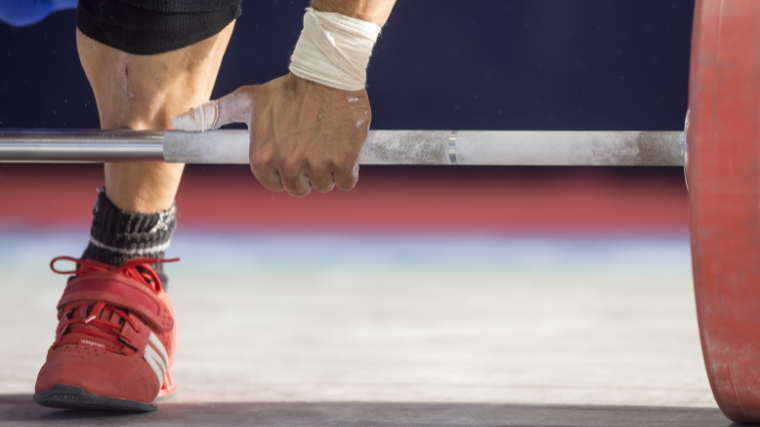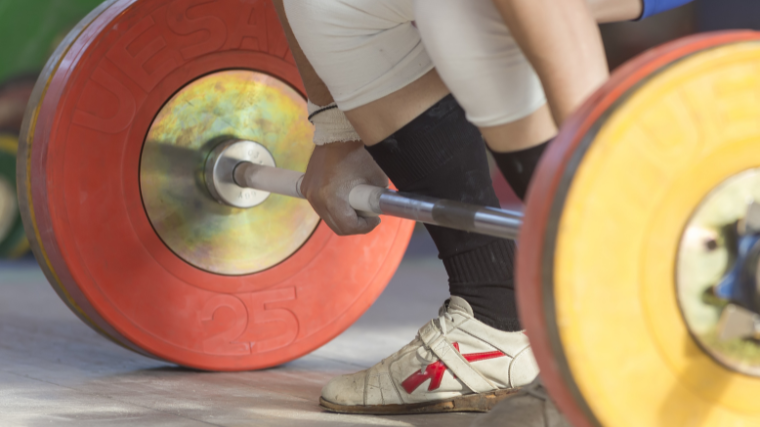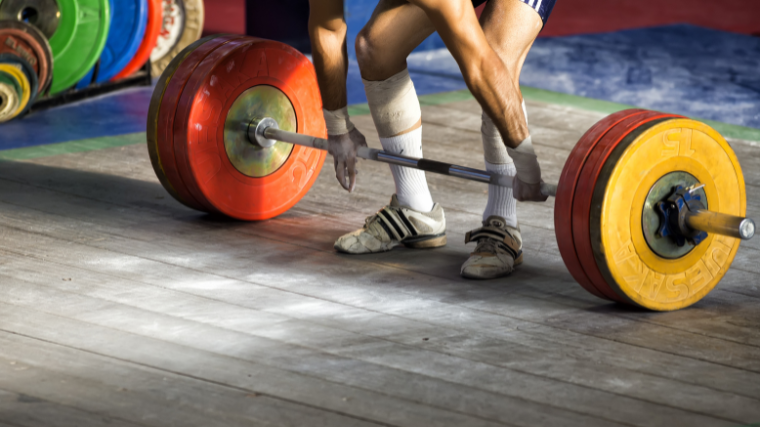If you’re new to weightlifting and enjoy it, that’s a good sign. As you train for a while, it gets tempting to push to your limits and find out what your best snatch and clean & jerk really are. When your lifts are going well, you should embrace your increasing strength by hitting up a local weightlifting competition.
The best part of local meets is that you don’t have to qualify for them — you simply have to want to be there. If you can do the snatch and the clean & jerk in the gym, you’re eligible to participate regardless of the weight you lift.

You shouldn’t let anything hold you back from signing up for your first meet. These are the common mistakes to look out for at your first meet, and how to overcome them.
Common Mistakes at Your First Weightlifting Meet
- Not Reading the Rules
- Choosing the Wrong Weight Class
- Unrealistic Attempt Planning
- Warming Up Too Fast (or Slow)
- Being Nervous
Not Reading the Rules
The first step to doing a competition is signing up for the meet. Once you’ve done that, celebrate! Afterward, make sure that you read the rules and procedures of USA weightlifting competitions sooner than later for your best preparation.
Weightlifting meets have a specific, orderly structure so that your lifts can be considered valid results by USAW. There are strict guidelines on what defines a successful lift. One example is that you have to hold your lift overhead until the center judge cues you a “down” signal. There are many important rules you need to know beforehand, and not knowing them could cost you a lift or two.
How to Fix It
When the meet is coming up, get serious about practicing the rules sooner than later. If you’re participating in a sanctioned competition, the governing body in your region will have a rulebook available for you to reference.
But your research shouldn’t stop there. Check your email or the club’s social media for more information about the meet as it approaches. The more information you can find on how weightlifting competitions are run, the more prepared you’ll be.
Choosing the Wrong Weight Class
One of the first steps of competing is choosing your weight class when you sign up. To make weight, you have to weigh exactly as much or less than the designated amount, but you also have to weigh more than the class below it.
For example, to be a men’s 61-kilogram weightlifter, you have to weigh between 55.1 kilograms to 61.0 kilograms exactly. If you weigh even 61.01 kilograms, you didn’t make weight and are bumped up a class. If you’re overweight, you have up to an hour before the meet to officially make weight.
Since there are only 10 weight classes, there might not be one that you fill out perfectly. To avoid any problems with making weight on meet day, make sure you sign up for the right class.
How to Fix It
First, weigh yourself. Observe which weight class you fit in naturally. Choose the weight class that best compliments your walk-around weight, especially for your first meet. This way, you won’t have to adjust or reduce your body weight.
Sometimes, cutting a small amount of weight to fit a class is an option. You should only cut within a few kilograms of your desired class because large weight cuts may compromise your strength. (1)

There are safe and effective strategies for cutting weight, such as adjusting your nutrition. Many local meets allow you to submit a change of weight class up to one week before the meet.
Unrealistic Attempt Planning
On meet day, you should have a plan of what you want to lift. You have three attempts of both the snatch and the clean & jerk. If you miss a lift, it still counts as one of your attempts, and you also can’t go back down in weight.
Your lifts have the best chance of being successful when your plans are realistic. You should feel motivated to go heavy, but also attempt numbers that align with your abilities on the day. Especially when it’s your first meet, trying to go too heavy might cost you.
How to Fix It
You should give extra care to your “openers,” which are the first snatch and clean & jerk that you do on the platform. To give you a sense of what you can do, hit your openers in training before the meet to see how they feel. Your openers at the meet determine what you should (and can) do next, so be ready to decide what jump you’re going to make while you’re there.
You can still plan and practice your predicted jumps ahead of time in training. On heavy days, and observe what weights you can hit confidently and use those as your openers. For example, if there’s a risk of pressing out the lift, approach with caution since it may not count at the meet.
Warming Up Too Fast (or Slow)
You might be wondering when you should start warming up at the meet. The cards on the table are always moving around, because lifters can change their weight declaration up to twice for each attempt.
Due to this, the amount of time you have before you take the stage can change often. Many factors influence the amount of time that remains before it’s your turn, which can make it hard to pace your warm-up.

Timing your warm-ups correctly is absolutely crucial. Going too slow might reduce your readiness, but rushing things leaves you with an abundance of time before they call you to the platform. There are a few tricks to timing your warm-up just right.
How to Fix It
Before the meet, prepare a detailed plan for your warm-ups in both the snatch and the clean & jerk. When the session starts, check the order of the lifters by looking at the cards table. See where you fall in the order to determine how long there is before you go.
You should also observe what weights the other lifters are opening with. If the other lifters are opening much lighter than you, they could take several attempts before you go for one.
Stay flexible when warming up. For example, If it’s taking longer than expected for your turn, add an extra light attempt or pull to stay warm.
Avoid doing too many attempts in your warm-up so that you don’t become fatigued before your heavy lifts. If your warm-up gets cut short, don’t panic. Do what you can, and be confident when taking the platform.
Being Nervous
Competition day is full of excitement. Lifting at the meet is much different than just a regular day at the gym because you’re supposed to hit your best lifts when they matter most. It’s easy to get nervous, but being too nervous could cost you.
Nervousness comes from thinking too much about what could go wrong (2). When you dwell on the negative possibilities, there’s a better chance of them actually taking place. Feeling nervous can also stimulate your adrenaline, which tires you out physically. You have to conserve your energy throughout the day to remain in control.
How to Fix It
On meet day, stay calm and trust your strength. Make a plan ahead of time, and while you’re there, stick to it. If your nerves are out of control in the warm-up, you can always adjust your forthcoming attempts to be a little lighter.
No matter what the weight is, be ready for your lift. You most likely worked very hard to get to your first competition, and you should be proud. The lifts at the meet are (hopefully) the same ones that you’ve hit in the gym, so don’t overcomplicate them.
You have a better chance of hitting your lifts when you’re confident.
How Weightlifting Meets Work
Meet day starts at the weigh-ins, which are a few hours before your lifting session starts. If you’re not on your weight when they call you, you have up to one hour before the competition to officially “make weight” and compete.
There’s a table in the warm-up area where each lifter has a card with their opening attempts on it. The competition proceeds from lowest to highest declared weight on the bar, so the cards are in order from lowest to highest attempt. On the lifter’s card, all three attempts are recorded during the session and determine the order of the lifters.
Once the bar is loaded for you, a one-minute clock starts. The bar has to leave the floor within that minute. If you miss the lift, the organizers leave the same weight on the bar for you. If the lift is successful, there’s an automatic one-kilogram increase for your next lift until you declare the weight you want for your next try.
After the snatch, there’s a short break before the clean & jerk session starts. The cards are placed in order exactly like the snatch for the clean & jerk portion. Once you complete all six lifts, your best snatch and clean & jerk are added together for your Total, which determines your overall ranking.
What to Bring to Your First Weightlifting Meet
Don’t make the mistake of forgetting something important. These are some essential items for the competition.
Your Singlet
The necessary attire for a competition is a singlet, which is a tight-fitting one-piece garment with shorts and short sleeves. There are certain rules for your singlet, as well as what you are or aren’t allowed to wear with it.
More information on the costume rules is listed in the International Weightlifting Federation’s official competition handbook.
Weightlifting Equipment
If you use equipment such as a weightlifting belt, wrist wraps, or knee sleeves for your lifts in the gym, you should have them with you at the meet.
Certain rules also exist in the IWF Handbook to specify equipment guidelines, such as that your weightlifting belt has to be within certain width dimensions.
Photo Identification
To verify your enrollment at the competition, the officials will ask for some form identification and your federation ID as well. Make sure you can identify yourself and confirm your membership when you check in.
Fuel and Hydration
Weightlifting meets often run long, so plan to eat and drink frequently. You should eat right after weigh-ins, especially if you ate lightly to make weight. Prepare food and hydration for the day beforehand to sustain your energy.
Work Smarter, Not Harder
To perform at your best in weightlifting, you have to have a strategy. Of course, you have to be strong, but you also have to make smart decisions on what your next move will be. Even if it’s your first meet, you can still be ready for the major potential obstacles.
Trust your plan, but be ready for anything. An exciting part of competing is that you never know what will happen or how you’ll feel. Some mistakes make it feel like six lifts just aren’t enough, but it’s what keeps weightlifting exciting. Do your best to remain in control, and use the possible outcomes to your benefit.
References
1. Moore, J. L., Travis, S. K., Lee, M. L., & Stone, M. H. (2019). Making weight: Maintaining body mass for weight class barbell athletes. Strength & Conditioning Journal, 41(6), 110-114.
2. Do Nascimento, I. B., Pereira, K. R., de Bulhões Gomes, F. M. M., Fleig, R., & Roesler, H. (2022). Strategies used in the Olympic weightlifting and psychological aspects: Factors that contemplate sports performance. Scientia Plena, 18(4).
Featured Image: Ververidis Vasilis / Shutterstock